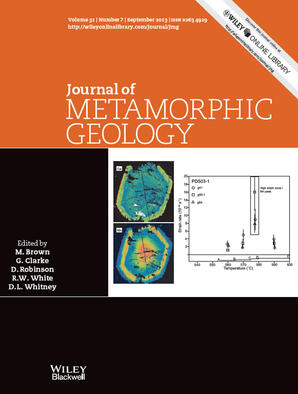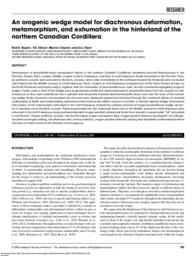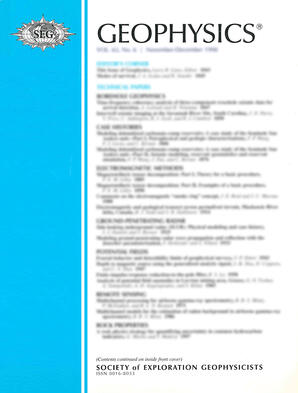Earth and Environmental Sciences
Related Works
Content type
Digital Document
Abstract
Amphibolite facies metasedimentary schists within the Yukon-Tanana terrane in the northern Canadian Cordillera reveal a two-stage, polymetamorphic garnet growth history. In situ U-Th-Pb Sensitive High Resolution Ion Microprobe dating of monazite provide timing constraints for the late stages of garnet growth, deformation and subsequent decompression. Distinct textural and chemical growth zoning domains, separated by a large chemical discontinuity, reveal two stages of garnet growth characterized in part by: (i) a syn-kinematic, inclusion-rich stage-1 garnet core; and (ii) an inclusion-poor, stage-2 garnet rim that crystallized with syn- to post-kinematic staurolite and kyanite. Phase equilibria modelling of garnet molar and compositional isopleths suggest stage-1 garnet growth initiated at ~600 °C, 8 kbar along a clockwise P-T path. Growth of the compositionally distinct, grossular-rich, pyrope-poor inner portion of the stage-2 overgrowth is interpreted to have initiated at higher pressure and/or lower temperature than the stage-1 core along a separate P-T loop, culminating at peak P-T conditions of ~650-680 °C and 9 kbar. Stage-2 metamorphism and the waning development of a composite transposition foliation ( ST) are dated at c. 118 Ma from monazite aligned parallel to ST, and inclusions in syn- to post- ST staurolite and kyanite. Slightly younger ages ( c. 112 Ma) are obtained from Y-rich monazite that occurs within resorbed areas of both stage-1 and stage-2 garnet, together with retrograde staurolite and plagioclase. The younger ages obtained from these texturally and chemically distinct grains are interpreted, with the aid of phase equilibria calculations, to date the growth of monazite from the breakdown of garnet during decompression at c. 112 Ma. Evidence for continued near-isothermal decompression is provided by the presence of retrograde sillimanite, and cordierite after staurolite, which indicates decompression below ~4-5 kbar prior to cooling below ~550 °C. As most other parts of the Yukon-Tanana terrane were exhumed to upper crustal levels in the Early Jurassic, these data suggest this domain represents a tectonic window revealing a much younger, high-grade tectono-metamorphic core (infrastructure) within the northern Cordilleran orogen. This window may be akin to extensional core complexes identified in east-central Alaska and in the southeastern Canadian Cordillera. [ABSTRACT FROM AUTHOR]
Origin Information
Content type
Digital Document
Abstract
Development of amphibolite-facies transposition fabrics in the northern Canadian Cordilleran hinterland occurred diachronously in the Permian–Triassic, Early Jurassic, Middle Jurassic to Early Cretaceous, and Early to mid-Cretaceous. Rocks tectonized in the Permian–Trias- sic and Early Jurassic were exhumed in the Early Jurassic, while rocks immediately to the northeast (toward the foreland) were not buried and heated until the Middle Jurassic to mid-Cretaceous. Early Jurassic to mid-Cretaceous emplacement of the Yukon-Tanana terrane on the North American continental margin, together with the imbrication of parautochthonous rocks, formed a foreland-propagating orogenic wedge. Cooler rocks in front of the wedge were progressively buried and metamorphosed to amphibolite facies from the Jurassic to mid- Cretaceous as they were underthrust into a spatially and temporally transient distributed ductile shear zone near the base of the overrid- ing wedge. Rocks previously incorporated into this zone were displaced upward and exhumed through the combined effects of renewed underplating at depth and compensating extensional and erosional denudation above to maintain a critically tapered wedge. Extensional exhumation of the metamorphic hinterland in the mid-Cretaceous marked the collapse and end of orogen-perpendicular wedge dynam- ics in operation since the Early Jurassic. Rocks incorporated into the midcrustal shear zone in the Middle Jurassic to mid-Cretaceous were exhumed in the mid-Cretaceous along southeast-directed (orogen-parallel) extensional faults from beneath a supracrustal “lid” tectonized in the Permian–Triassic and Early Jurassic. Like the Himalayan orogen and eastern Alps, orogen-parallel extension developed in an orthogo- nal plate-convergent setting, simultaneous with, and bounded by, orogen-parallel strike-slip faulting that facilitated northwestward lateral extrusion of rocks normal to the direction of convergence.
Origin Information
Content type
Digital Document
Abstract
Sierra Negra volcano, the most voluminous shield volcano in the Galápagos archipelago and one of the largest basaltic calderas in the world, erupted on October 22, 2005 after more than 25years of quiescence. GPS and satellite radar interferometry (InSAR) monitoring of the deformation of the caldera floor in the months prior to the eruption documented extraordinary inflation rates (1cm/day). The total amount of uplift recorded since monitoring began in 1992 approached 5m at the center of the caldera over the eight days of the eruption the caldera floor deflated a maximum of 5 m and subsquently renewed its inflation, but at a decelerating rate. To gain insight into the nature of the subsurface mass/density changes associated with the deformation, gravity measurements performed in 2005, 2006, and 2007 are compared to previous measurements from 2001-2002 when the volcano underwent a period of minor deflation and magma withdrawal. The residual gravity decrease between 2001-2002 and 2005 is among the largest ever recorded at an active volcano (−950 μGal) and suggests that inflation was accompanied by a relative density decrease in the magmatic system. Forward modeling of the residual gravity data in 4D (from 2002 to 2005) gives an estimate of the amount of vesiculation in the shallow sill required to explain the observed gravity variations. Geochemical constraints from melt inclusion and satellite remote-sensing data allow us to estimate the pre-eruptive gas content of the magma and place constraints on the thickness of the gas-rich sill necessary to produce the gravity anomalies observed. Results suggest that reasonable sill thicknesses (700–800m) and bubble contents (10–50 volume %) can explain the large decrease in residual gravity prior to eruption. Following the eruption (2006 and 2007), the deformation and gravity patterns suggest re-equilibration of the pressure regime in the shallow magma system via a renewed influx of relatively gas-poor magma into the shallow parts of the system.
Origin Information



